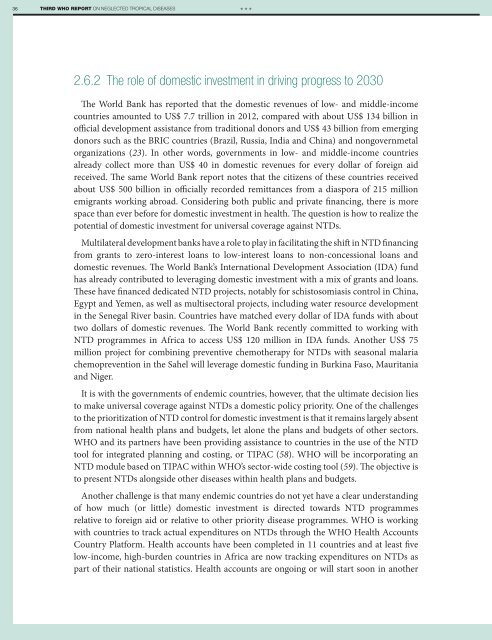1A9bnbK
1A9bnbK
1A9bnbK
Create successful ePaper yourself
Turn your PDF publications into a flip-book with our unique Google optimized e-Paper software.
36 THIRD WHO REPORT ON NEGLECTED TROPICAL DISEASES<br />
***<br />
2.6.2 The role of domestic investment in driving progress to 2030<br />
The World Bank has reported that the domestic revenues of low- and middle-income<br />
countries amounted to US$ 7.7 trillion in 2012, compared with about US$ 134 billion in<br />
official development assistance from traditional donors and US$ 43 billion from emerging<br />
donors such as the BRIC countries (Brazil, Russia, India and China) and nongovernmetal<br />
organizations (23). In other words, governments in low- and middle-income countries<br />
already collect more than US$ 40 in domestic revenues for every dollar of foreign aid<br />
received. The same World Bank report notes that the citizens of these countries received<br />
about US$ 500 billion in officially recorded remittances from a diaspora of 215 million<br />
emigrants working abroad. Considering both public and private financing, there is more<br />
space than ever before for domestic investment in health. The question is how to realize the<br />
potential of domestic investment for universal coverage against NTDs.<br />
Multilateral development banks have a role to play in facilitating the shift in NTD financing<br />
from grants to zero-interest loans to low-interest loans to non-concessional loans and<br />
domestic revenues. The World Bank’s International Development Association (IDA) fund<br />
has already contributed to leveraging domestic investment with a mix of grants and loans.<br />
These have financed dedicated NTD projects, notably for schistosomiasis control in China,<br />
Egypt and Yemen, as well as multisectoral projects, including water resource development<br />
in the Senegal River basin. Countries have matched every dollar of IDA funds with about<br />
two dollars of domestic revenues. The World Bank recently committed to working with<br />
NTD programmes in Africa to access US$ 120 million in IDA funds. Another US$ 75<br />
million project for combining preventive chemotherapy for NTDs with seasonal malaria<br />
chemoprevention in the Sahel will leverage domestic funding in Burkina Faso, Mauritania<br />
and Niger.<br />
It is with the governments of endemic countries, however, that the ultimate decision lies<br />
to make universal coverage against NTDs a domestic policy priority. One of the challenges<br />
to the prioritization of NTD control for domestic investment is that it remains largely absent<br />
from national health plans and budgets, let alone the plans and budgets of other sectors.<br />
WHO and its partners have been providing assistance to countries in the use of the NTD<br />
tool for integrated planning and costing, or TIPAC (58). WHO will be incorporating an<br />
NTD module based on TIPAC within WHO’s sector-wide costing tool (59). The objective is<br />
to present NTDs alongside other diseases within health plans and budgets.<br />
Another challenge is that many endemic countries do not yet have a clear understanding<br />
of how much (or little) domestic investment is directed towards NTD programmes<br />
relative to foreign aid or relative to other priority disease programmes. WHO is working<br />
with countries to track actual expenditures on NTDs through the WHO Health Accounts<br />
Country Platform. Health accounts have been completed in 11 countries and at least five<br />
low-income, high-burden countries in Africa are now tracking expenditures on NTDs as<br />
part of their national statistics. Health accounts are ongoing or will start soon in another


